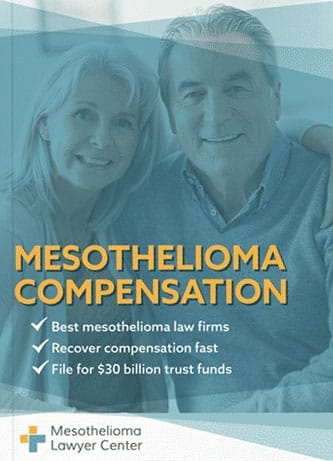Amatex Corporation made asbestos textiles until the early 1980s. The company filed for bankruptcy after facing numerous asbestos lawsuits. Amatex put its own workers and workers in other industries at risk of exposure to asbestos and resulting illnesses like mesothelioma.
If you or a loved one were diagnosed with mesothelioma or any other illness due to asbestos exposure, you might be entitled to substantial compensation. Fill out our form to get a free Financial Compensation Packet. You’ll learn about the experienced mesothelioma lawyers in your area, how to get paid in 90 days, how to file a claim for the asbestos trust funds, and more.


FREE Financial Compensation Packet
- Info on law firms that will recover your HIGHEST COMPENSATION
- Learn how to get paid in 90 days
- File for your share of $30 billion in trust funds

Did Amatex Use Asbestos?
Amatex made heat-resistant textiles with asbestos for decades. Asbestos was long a prized material for insulation and for strengthening various products and making them more heat- or fire-resistant.
Amatex began using asbestos in textiles in the 1950s and continued this practice through the early 1980s. Now owned by a different company, the products it makes today do not contain asbestos.
Amatex Corporation History
Established as the American Asbestos Textile Corp in the 1950s, Amatex started as a textile manufacturer in Norristown, Pennsylvania.
- Most of the company’s products were made to resist hot temperatures and fire, including insulation, ropes, gaskets, wicks, and cloth.
- Amatex purchased a second manufacturing facility in Meridith, New Hampshire, from Keasbey & Mattison in 1962.
- To make their products fire and heat-resistant, Amatex used asbestos. It was affordable and easy to mix into materials.
- Amatex stopped using asbestos in its products, but this was many years after the company already knew how dangerous it was to expose workers to toxic asbestos fibers.
- Today, it operates in Laconia, New Hampshire, making high-temperature materials with fiberglass instead of asbestos.
Amatex faced numerous asbestos-related lawsuits, resulting in more than 9,000 claims. Davlyn Group, a global textile manufacturer, acquired Amatex in 2020.
How Did Amatex Use Asbestos?
Asbestos was once a highly desirable material for many industrial applications. For companies like Amatex that made heat-resistant fabrics, asbestos was inexpensive, efficient, and readily available.
Amatex used asbestos in textiles from the early 1950s through the early 1980s. Many other industries used Amatex asbestos products, including heat-protective safety gear, furnace seals, heat-resistant tapes, and more. Examples of Amatex products that contained asbestos include:
- Carded fiber
- Cloth
- Cords
- Lap
- Rope
- Roving
- Tape
- Tubing
- Wick
- Yarn
Amatex asbestos textile brands included Quietline, Safecote, Thermalon, and Titegrip.
Who Was at Risk of Exposure to Amatex Asbestos Textiles?
Amatex workers who manufactured asbestos textiles were at high risk for exposure. By handling and being around asbestos, they were at risk of inhaling asbestos fibers.
Amatex textiles were used in many other industries. Anyone working with their products in other workplaces risked exposure to asbestos. Some of the types of workers who may have handled Amatex asbestos products include:
- Automotive plant workers
- Boiler workers
- Chemical plant workers
- Construction workers
- HVAC installers and repairers
- Insulation workers
- Oil and petroleum workers
- Pipefitters
- Shipyard workers
Amatex Asbestos Lawsuits
After decades of using asbestos in its products, Amatex faced numerous lawsuits. Some workers exposed to asbestos fibers through Amatex textiles developed illnesses like mesothelioma, lung cancer, and asbestosis and sued the company for damages.
One example was a lawsuit brought by Ernest Cleveland. He worked in a shipyard and handled asbestos products from many different companies. He developed asbestosis in the early 1980s and sued Amatex and other companies involved in his asbestos exposure.
Amatex settled with Cleveland, but his case went forward with other defendants, resulting in a $1.5 million award.
Cleveland’s was one of nearly 10,000 asbestos lawsuits against Amatex that would ultimately send the company to Chapter 11 bankruptcy protection.
Amatex Settlement Trust
With the sheer amount of asbestos-related lawsuits, Amatex filed for Chapter 11 bankruptcy in the 1980s.
Stipulations under the company’s Chapter 11 bankruptcy mandated they create a Creditors’ Committee of Asbestos Litigants to compensate current plaintiffs.
The Amatex Asbestos Disease Trust Fund was also created to handle future asbestos claims. Although the trust fund is now inactive, the company paid out more than $11 million in settlement amounts during the first decade alone.
In 1990, Amatex came out of bankruptcy and re-established the company. Even though they no longer use asbestos, Amex continues to manufacture heat and fire-resistant materials.
What to Do if You Used Amatex Asbestos Products
Talk to your doctor if you were exposed to asbestos through Amatex or other companies. Early diagnosis is the best way to improve your prognosis for an asbestos illness.
A mesothelioma lawyer can help you seek compensation. Because it reorganized under bankruptcy, Amatex cannot be sued. A lawyer can help you find other ways to seek compensation, including asbestos trusts or lawsuits against other companies that exposed you to asbestos.
Additional Help and Legal Resources for Asbestos Victims
Don’t forget to fill out our form to get our free Financial Compensation Packet, filled with information on the experienced asbestos and mesothelioma attorneys in your area. For additional assistance, contact us at 800-793-4540.

Paul Danziger
Reviewer and EditorPaul Danziger grew up in Houston, Texas and earned a law degree from Northwestern University School of Law in Chicago. For over 25 years years he has focused on representing mesothelioma cancer victims and others hurt by asbestos exposure. Paul and his law firm have represented thousands of people diagnosed with mesothelioma, asbestosis, and lung cancer, recovering significant compensation for injured clients. Every client is extremely important to Paul and he will take every call from clients who want to speak with him. Paul and his law firm handle mesothelioma cases throughout the United States.
References
- Davlyn Group. (2020, December 3). Davlyn Group Acquires Norfab-Amatex.
Retrieved from: https://www.davlyngroup.com/davlyn-group-acquires-norfab-amatex-2/ - Dixon, L., McGovern, G., and Coombe, A. (2010). Asbestos Bankruptcy Trusts. An Overview of Trust Structure and Activity with Detailed Reports on the Largest Trusts. Rand Institute for Civil Justice.
Retrieved from: http://www.rand.org/content/dam/rand/pubs/technical_reports/2010/RAND_TR872.pdf - U.S. Bankruptcy Court for the Eastern District of Pennsylvania. (n.d.). Notice To Persons Who May Have An Asbestosis Disease Claim Against Amatex Corporation.
Retrieved from: http://cases.gcginc.com/pdf/ATX/ATXNotice.pdf
